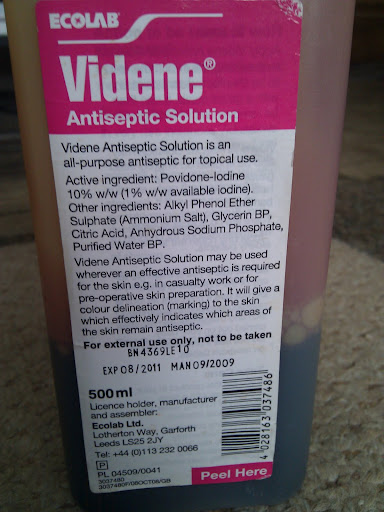BigYin said:
So what are these other chemicals?
I'll see what my bottle of videne lists :hmm:
The ingredients list all check out to be safe (unless your a fish!) but still I'm not willing to take any risk. In fact the MSDS only lists Glycerine and Polyvinylpyrrolidone iodine as being hazedous and goes on to say "There are no additional ingredients present which, within the current knowledge of the supplier and in the concentrations applicable, are classified as hazardous to health or the environment and hence require reporting in this section" and under the Toxicological information, Potential acute health effects for Ingestion it says "No known significant effects or critical hazards"
Thing is though this is for it's intended use as a "Skin antiseptic" for "professional use only" and it even says on the bottle "For external use only, not to be taken"
The company has a licence which will say this and any other use is not licenced. For me if, even at no-rinse solutions, it is not to be taken then I'll be replacing mine with something designed for the job!
here's my bottle:
Here are the ingredients:
povidone (Polyvinylpyrrolidone or PVP)-Iodine 10% w/w (1% available iodine) - the PVP is a wetting/film agent which is safe as it should just pass through your body.
Alkyl Phenol Ether Sulphate (Ammonium salt) - Surfactants (detergent/wetting agent)
Glycerin BP - moisturiser
Citric acid - acts as a buffer
Anhydrous Sodium Phosphate - acts as a buffer with the Citric acid, present to form a buffer to maintain a pH of between 3 and 5.5
Purified Water BP
If you can be bothered to read it all ( :) )here is what the company has to say
"Videne Antiseptic Solution
Trade Name of the Medicinal Product: Videne Antiseptic Solution. Qualitative and
Quantitative Composition: Povidone-iodine 10% w/w Pharmaceutical Form:Topical
Solution. Clinical Particulars - Therapeutic Indications: Videne Antiseptic Solution
is a broad-spectrum antiseptic for topical use. It may be used whenever an effective
antiseptic is required for the skin eg in casualty work or for pre-operative skin
preparation. It will give a colour delineation to the skin which effectively indicates
which areas of the skin remain antiseptic.Posology and Method of Administration:
Videne Antiseptic Solution is applied undiluted to the skin in the area to be
disinfected painting on with a gauze swab. It can then be removed with sterile
gauze swabs. Videne Antiseptic Solution may also be applied on impregnated gauze
swabs which are then held on to the skin with bandages. There are no special
dosage recommendations for children or elderly patients. Contra-indications:
Videne Antiseptic Solution must never be administered orally. Special Warning and
Precautions for Use: Care should be taken with known iodine-sensitive subjects,
although such people do not normally react to povidone-iodine. Interactions with
Other Medicinal Products and Other Forms of Interaction: None stated.
Pregnancy and Lactation: Videne Antiseptic Solution is not recommended for use
during pregnancy because of the possibility of absorption through broken skin and
subsequent interference with tests of neonatal thyroid function. Effects on Ability to
Drive and Use Machines: None stated. Undesirable Effects: In very rare instances
Videne Antiseptic Solution may produce skin reactions in iodine-sensitive subjects.
These reactions subside on cessation of treatment.Overdose: In cases where
Videne Antiseptic Solution has been taken orally, gastric lavage with dilute starch
mucilage or a 1% solution of sodium thiosulphate must be administered. The
electrolyte balance must be corrected and lost fluids replaced. Pharmacological
Properties: Pharmacodynamic Properties: Povidone-iodine has antiseptic activity
and is used mainly for the treatment of contaminated wounds and pre-operative
preparation of skin and mucous membranes. It is considered to be less irritant than
iodine.Pharmacokinetic Properties: Povidone-iodine is slightly absorbed when
applied to the skin. Iodides are excreted mainly in the urine, with smaller amounts
appearing in the faeces, saliva and sweat. Preclinical Safety Data: Povidone-iodine
had a low acute toxicity in both dogs and rats following either oral or intraperitoneal
administration. Absorption of iodine through intact skin is low following the
application of solutions of povidone-iodine although systemic absorption of iodine
is greatly increased if the solutions are applied to broken skin, mucous membranes
or are introduced into cavities of the body. At subcutaneous dose levels of up to
75mg/kg/day, povidone-iodine was non-teratogenic in rabbits following
administration to pregnant animals during the period of organogenesis. Some early
in vitro studies indicated a possible mutagenic action for povidone-iodine. However,
a number of later studies, using in vitro and in vivo test systems, do not indicate a
significant level of mutagenic/genotoxic activity for povidone-iodine. Although
conflicting data have been published, there is no convincing evidence to suggest
that povidone-iodine adversely affects wound healing. Concentration of 0.05 and
0.5% povidone-iodine did not cause significant ocular damage when administered
into the vitreous cavities of rabbitsâ eyes. There is some evidence to suggest that
povidone-iodine-containing solutions applied to the round window of the chinchilla
ear could result in high frequency hearing loss. Pharmaceutical Particulars - List
of Excipients: Alkyl Phenol Ether Sulphate (Ammonium Salt), Glycerol, Citric Acid
Di-sodium Phosphate Anhydrous, Purified Water BP Incompatibilities: None stated.
Shelf Life: 24 months. Special Precautions for Storage: Store below 30°C in a dry
place, protected from light. Nature and Contents of Container: Videne Antiseptic
Solution is packaged in a 500ml HDPE bottle sealed with a plastic screw cap.
Instructions for Use and Handling: None stated. Legal Category: P Cost: Unit
price £1.85 Marketing Authorisation Holder: Ecolab Ltd trading as Adams
Healthcare, Lotherton Way, Garforth, Leeds, LS25 2JY. Marketing Authorisation
Number: PL 04509/0041. Date of Preparation: 1 March 2003."
Yes I know! £1.85 - I was ripped off :lol:






































![BREWING THERMOMETER STICKERS ACCURATELY MONITOR FERMENTING BEER & WINE LIQUID TEMPERATURES 5PCS HOME BREW SPIRITS WINE LCD ADHESIVE [US]](https://m.media-amazon.com/images/I/311DDjo2X3L._SL500_.jpg)



